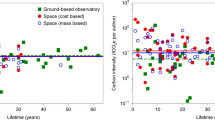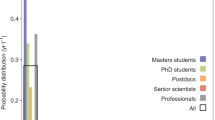Abstract
Astronomical observatories have been identified as substantial contributors to the carbon footprint of astrophysical research. Being part of the collaboration that is currently developing the medium-sized telescopes in the Cherenkov Telescope Array, a ground-based observatory for very-high-energy γ-rays that will comprise 64 telescopes deployed on two sites, we assessed the environmental impacts of one medium-sized telescope on the northern site with a life-cycle assessment. We identified resource use and climate change as having the most significant impacts due to telescope manufacturing and energy consumption during operations. We estimate life-cycle greenhouse gas emissions of 2,660 ± 274 tCO2e for the telescope, 44% of which arise from construction, 1% from on-site assembly and commissioning and 55% from operations over 30 yr. The environmental impacts could be reduced by using renewable energy during construction and operations, using fewer electronic components and metal casting and using recycled materials. We propose complementing the project requirements with environmental budgets as an effective measure for impact management and reductions.
This is a preview of subscription content, access via your institution
Access options
Access Nature and 54 other Nature Portfolio journals
Get Nature+, our best-value online-access subscription
$29.99 / 30 days
cancel any time
Subscribe to this journal
Receive 12 digital issues and online access to articles
$119.00 per year
only $9.92 per issue
Buy this article
- Purchase on SpringerLink
- Instant access to full article PDF
Prices may be subject to local taxes which are calculated during checkout




Similar content being viewed by others
Data availability
All data used for this study are available for download via Zenodo at https://zenodo.org/records/11915488 (ref. 26).
References
Richardson, K. et al. Earth beyond six of nine planetary boundaries. Sci. Adv. 9, eadh2458 (2023).
IPCC Climate Change 2021: The Physical Science Basis (eds Masson-Delmotte, V. et al.) (Cambridge Univ. Press, 2021).
Brondizio, E. S., Settele, J., Díaz, S. & Ngo, H. T. (eds) Global Assessment Report of the Intergovernmental Science-Policy Platform on Biodiversity and Ecosystem Services (IPBES, 2019).
Oberle, B. et al. (eds) Global Resources Outlook 2019: Natural Resources for the Future We Want (IRP, 2019).
Baste, I. A. & Watson, R. T. Tackling the climate, biodiversity and pollution emergencies by making peace with nature 50 years after the Stockholm Conference. Glob. Environ. Change 73, 102466 (2022).
Rosen, J. A greener culture. Nature 546, 565–567 (2017).
Knödlseder, J. in Climate Change for Astronomers: Causes, Consequences, and Communication (ed. Rector, T.) 18-1–18-23 (AAS-IOP, 2024).
Knödlseder, J. et al. Estimate of the carbon footprint of astronomical research infrastructures. Nat. Astron. 6, 503–513 (2022).
Kruithof, G. et al. The energy consumption and carbon footprint of the LOFAR telescope. Exp. Astron. 56, 687–714 (2023).
Vargas-Ibáñez, L. T. et al. Life cycle analysis of the GRAND experiment. Astropart. Phys. 155, 102903 (2024).
Viole, I. et al. Sustainable astronomy: a comparative life cycle assessment of off-grid hybrid energy systems to supply large telescopes. Int. J. Life Cycle Assess. https://doi.org/10.1007/s11367-024-02288-9 (2024).
Barret, D. et al. Life cycle analysis of the Athena X-ray integral field unit. Exp. Astron. 57, 19 (2024).
Hofmann, W. & Zanin, R. in Handbook of X-ray and Gamma-ray Astrophysics (eds Bambi, C. & Santangelo, A.) 1–47 (Springer, 2022).
Cabrera, S. M. La Palma como espejo. Energ. Renov. https://www.energias-renovables.com/panorama/la-palma-como-espejo--20231211 (2023).
Sala, S., Cerutti, A. K. & Pant, R. Development of a Weighting Approach for the Environmental Footprint JRC Technical Report 106546 (European Commission, 2018).
Brander, M., Gillenwater, M. & Ascui, F. Creative accounting: a critical perspective on the market-based method for reporting purchased electricity (scope 2) emissions. Energy Policy 112, 29–33 (2018).
El Sistema Eléctrico Español: Avance (Red Electrica de España, 2015); www.ree.es/sites/default/files/downloadable/avance_informe_sistema_electrico_2015_v2.pdf
Ramirez-Diaz, A., Ramos-Real, F. J. & Marrero, G. A. Complementarity of electric vehicles and pumped-hydro as energy storage in small isolated energy systems: case of La Palma, Canary Islands. J. Mod. Power Syst. Clean Energy 4, 604–614 (2016).
International Organization for Standardization Environmental Management – Life Cycle Assessment – Principles and Framework ISO 14040:2006-10 (ISO, 2022).
Bretz, T. et al. A status report: FACT—a fact! In Proc. 13th ICATPP Conference on Astroparticle, Particle, Space Physics and Detectors for Physics Applications (eds Simone, G. et al.) 29–33 (World Scientific, 2012).
Chanoine, A., Duvernois, P.-A. & Le Guern, Y. Environmental Impact Assessment Analysis Technical Note D8 (ESA, 2017); https://nebula.esa.int/sites/default/files/neb_study/1116/C4000104787ExS.pdf
ESA LCA Working Group Space System Life Cycle Assessment (LCA) Guidelines Report ESSB-HB-U-005, Issue 1, Revision 0 (ESA, 2016).
Martin, P. et al. A comprehensive assessment of the carbon footprint of an astronomical institute. Nat. Astron. 6, 1219–1222 (2022).
La Palombara, N. et al. Mirror production for the Cherenkov telescopes of the ASTRI mini-array and the MST project for the Cherenkov Telescope Array. J. Astron. Telesc. Instrum. Syst. 8, 014005 (2022).
El Anuario Energético de Canarias (2021); https://www3.gobiernodecanarias.org/ceic/energia/oecan/files/AnuarioEnergeticoCanarias_2021_v2.pdf
Knödlseder, J. et al. Assessment of the environmental impacts of the Cherenkov Telescope Array mid-sized telescope. Zenodo https://doi.org/10.5281/zenodo.10642351 (2024).
Hunter, J. D. Matplotlib: a 2D graphics environment. Comput. Sci. Eng. 9, 90–95 (2007).
Acknowledgements
We thank all members of the MSTN and NectarCAM collaborations who supported this study by providing information and data. We are grateful to M. Garczarczyk and O. Ferreira for having granted permission to use their drawings in Supplementary Fig. 1. We also thank X. Loizillon from the company Scalian for valuable discussions. We furthermore thank the French National Centre for Space Studies for enabling the licences for the software SimaPro and ecoinvent databases purchased for updating the LCA of the X-IFU instrument to be shared with this study. Finally, we thank the members of the Labos1point5 research group for valuable discussions and for providing training on the LCA method. This study was financed in part by the Coordenação de Aperfeiçoamento de Pessoal de Nível Superior, Brazil (Finance Code 001 to G.d.S.I.). This work was conducted in the context of the CTAO MSTN work package. This work has made use of the Python 2D plotting library matplotlib27.
Author information
Authors and Affiliations
Contributions
G.d.S.I. conducted the LCA, provided a detailed report on which this paper is based and contributed to the writing of the paper. M.B., J.K., P.G. and L.M. designed the study, supervised the LCA and contributed to the writing of the paper. P.J., G.P., A.S. and F.T. served as technical experts for the LCA, provided information to establish the LCI and reviewed the paper.
Corresponding author
Ethics declarations
Competing interests
The authors declare no competing interests.
Peer review
Peer review information
Nature Astronomy thanks Nils Thonemann and Isabelle Viole for their contribution to the peer review of this work.
Additional information
Publisher’s note Springer Nature remains neutral with regard to jurisdictional claims in published maps and institutional affiliations.
Extended data
Extended Data Fig. 1 System boundary of the life cyle assessment.
The end-of-life impacts were excluded from the analysis as decommissioning plans for MSTN are not yet elaborated.
Extended Data Fig. 2 Life cycle impacts of one MSTN for an alternative energy system on La Palma where diesel generators are to 56% replaced by renewable energies.
Panels show normalised (a), weighted (b) and single score life cycle impacts (c). The results correspond to 30 years of operations with an alternative energy system, assuming that a wind powered pumped hydro storage system is implemented in La Palma like the one that exists on the island of El Hierro. We assumed that 56% of the electricity demand that is currently covered by diesel generators on La Palma would be replaced by electricity from this system, which corresponds to the contribution that is currently achieved in El Hierro (see ‘Alternative energy systems for La Palma’ in Supplementary Information for details).
Extended Data Fig. 3 Life cycle impacts of one MSTN for an alternative energy system on La Palma where diesel generators are to 100% replaced by renewable energies.
Panels show normalised (a), weighted (b) and single score life cycle impacts (c). The results correspond to 30 years of operations with an alternative energy system, assuming that a wind powered pumped hydro storage system is implemented in La Palma like the one that exists on the island of El Hierro. We assumed that 100% of the electricity demand that is currently covered by diesel generators on La Palma would be replaced by electricity from this system (see ‘Alternative energy systems for La Palma’ in Supplementary Information for details).
Supplementary information
Supplementary Information
Supplementary Fig. 1, discussion and Tables 1–12.
Rights and permissions
Springer Nature or its licensor (e.g. a society or other partner) holds exclusive rights to this article under a publishing agreement with the author(s) or other rightsholder(s); author self-archiving of the accepted manuscript version of this article is solely governed by the terms of such publishing agreement and applicable law.
About this article
Cite this article
dos Santos Ilha, G., Boix, M., Knödlseder, J. et al. Assessment of the environmental impacts of the Cherenkov Telescope Array mid-sized telescope. Nat Astron (2024). https://doi.org/10.1038/s41550-024-02326-4
Received:
Accepted:
Published:
DOI: https://doi.org/10.1038/s41550-024-02326-4
This article is cited by
-
Scenarios of future annual carbon footprints of astronomical research infrastructures
Nature Astronomy (2024)



